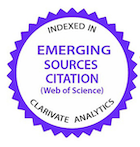Genetic parameters for jumping performance in Brazilian Sport Horses
DOI:
https://doi.org/10.1590/1809-6891v24e-75434EAbstract
This study aimed to estimate genetic parameters for jumping measures in the Brazilian Sport Horses breed, looking to see which jump characteristics can be evaluated early and that present favorable genetic correlations (ϒg) with measures of later sports performance. Data were available for the results of jumping competitions on the Brazilian Sport Horses. Two traits were calculated: Classification (CLASS) of the animal (taking into consideration obstacle height, number of competitors, type of competition (regional, national, international) and final score (SCOREF) taking into consideration the weight of the competition, height of the obstacles and score for the placement and type of event. Heritabilities were low for the full database (0.00 and 0.07 for CLASS and SCOREF, respectively), but higher when only young horses were considered (0.09 and 0.67, respectively). Genetic correlations between these traits and subjective functional traits (using a scale of 0 to 10) measured at stallion approval for reproduction showed that Power was favorable for indirect selection for both traits (-0.85 for CLASS and 1.00 for SCOREF). Jump also showed a favorable correlation for SCOREF (0.53) but unfavorable for CLASS (1.00). Considering the importance of Temperament and the absence of unfavorable genetic correlations between it and competition results it was concluded that this trait can be maintained among the selection objectives of Brazilian Sport Horses. Suggestions are made for further genetic studies with this breed, and possible modifications in the evaluation regulations to improve data quality.
Keywords: competition; final score; genetic correlations; heritability; temperament
Downloads
References
Medeiros BR, Garbade P, Seixas L, Peripolli V, McManus C. Brazilian Sport Horse: genetic parameters for approval of Brasileiro de Hipismo stallions. Trop. Anim. Health Prod. 2020; 52(4):1669-1680. https://doi.org/10.1007/s11250-019-02168-7.
Associação Brasileira de Criadores de Cavalos de Hipismo (ABCCH). Regulamento do Stud Book Brasileiro do Cavalo de Hipismo. [Internet]; 2011 [cited 2022 Mar 15]. Available from: http://brasileirodehipismo.com.br/site/upload/arquivos/regulamento.pdf. Portuguese.
Aldridge LI, Kelleher DL, Reilly M, Brophy PO. Estimation of the genetic correlation between performances at different levels of show jumping competitions in Ireland. J. Anim. Breed. Genet. 2000; 117(1): 65-72. https://doi.org/10.1046/j.1439-0388.2000.00232.x.
Posta J, Malovhr S, Mihók S, Komlósi I. Random regression model estimation of genetic parameters for show-jumping results of Hungarian Sport Horses. J. Anim. Breed. Genet. 2010; 127(4): 280-288. https://doi.org/10.1111/j.1439- 0388.2009.00848.x.
Viklund A, Braam Å, Näsholm A, Strandberg E, Philipsson J. Genetic variation in competition traits at different ages and time periods and correlations with traits at field tests of 4-year-old Swedish Warmblood horses. Animal. 2010; 4(5): 682-691, 1751-7311. https://doi.org/10.1017/S1751731110000017.
Bartolomé E, Menéndez-Buxadera A, Valera M, Cervantes I, Molina A. Genetic (co)variance components across age for Show Jumping performance as an estimation of phenotypic plasticity ability in Spanish horses. J. Anim. Breed Genet. 2013; 130(3):190-8. https://doi.org/10.1111/jbg.12001.
Thorén Hellsten E, Viklund Å, Koenen EPC, Ricard A, Bruns E, Philipsson J. Review of genetic parameters estimated at stallion and young horse performance tests and their correlations with later results in dressage and show-jumping competition. Livest. Sci. 2006; 103(1-2): 1-12. https://doi.org/10.1016/j.livsci.2006.01.004.
Associação Brasileira de Criadores de Cavalos de Hipismo (ABCCH). Consulta genealógica. [Internet]; 2022 [cited 2022 Mar 15]. Available from: https://www.abcch.com.br/?p=|studbook|genealogia. Portuguese.
Medeiros BR, Bertoli CD, Garbade P, McManus CM. Brazilian Sport Horse: pedigree analysis of the Brasileiro de Hipismo breed. Ital. J. Anim. Sci. 2014; 13(3): 657-664. https://doi.org/10.4081/ijas.2014.3146.
Associação Brasileira de Criadores de Cavalos de Hipismo (ABCCH). Estatística. [Internet]; 2022 [cited 2022 Mar 15]. Available from: https://www.abcch.com.br/?p=|estatistica|. Portuguese.
Confederação Brasileira de Hipismo (CBH). Regulamento Geral. [Internet]; 2013a [cited 2022 Mar 15]. Available from: http://www.cbh.org.br/regulamento.html. Portuguese.
Associação Brasileira de Criadores de Cavalos de Hipismo (ABCCH). Circuito do Cavalo Brasileiro de Hipismo. [Internet]; 2013 [cited 2022 Mar 15]. Available from: http://brasileirodehipismo.com.br/site/html/stbhhome.asp.
Confederação Brasileira de Hipismo (CBH). Regulamento de Salto. [Internet]; 2013b [cited 2022 Mar 15]. Available from: http://www.cbh.org.br/regulamento.html.
Akaike, H. Factor Analysis and AIC. Psychometrika. 1987; 52: 317-332. https://doi.org/10.1007/BF02294359.
Boldman KG, Kriese LA, Van Vleck D, Van Tassel CP, Kachman SD. A manual for use of MTDFREML. A set of programs to obtain estimates of variances and covariances [draft]. [Internet]. USA: Department of Agriculture. Agricultural Research Service; 1995 [cited 2022 Mar 15]. Available from: https://www.ars.usda.gov/ARSUserFiles/80420530/MTDFREML/MTDFMan.pdf
Confederação Brasileira de Hipismo (CBH). Campeonato Brasileiro de Salto. [Internet]; 2013c [cited 2022 Mar 15]. Available from: http://www.cbh.org.br/regulamento.html.
Ricard A, Legarra A. Validation of models for analysis of ranks in horse breeding evaluation. Genet. Sel. Evol. 2010; 42(3): 1-10. https://doi.org/10.1186/1297-9686-42-3.
Rovere G, Ducro BJ, van Arendonk JA, Norberg E, Madsen P. Analysis of competition performance in dressage and show jumping of Dutch Warmblood horses. J. Anim. Breed Genet. 2016; 133(6):503-512. https://doi.org/10.1111/jbg.12221.
Wallin L, Strandberg E, Philipsson J. Genetic correlations between field test results of Swedish Warmblood Riding Horses as 4-year-olds and lifetime performance results in dressage and show jumping. Livest. Prod. Sci. 2003; 82(1): 61-71. https://doi.org/10.1016/S0301-6226(02)00307-X.
Stewart I, Williams JA, Brotherstone S. Genetic evaluations of traits recorded in British young horse tests. Archiv. Tierzucht. 2011; 54(5): 439-455. https://doi.org/10.5194/aab-54-439-2011.
Neumann C, Čítek J, Janošíková M, Doležalová J, Starostová L, Stupka R. Effects of horse age and the number of riders on equine competitive performance. J. Vet. Behav. 2021; 41: 1-6. https://doi.org/10.1016/j.jveb.2020.10.002.
Kearsley CGS, Woolliams JA, Coffey MP, Brotherstone S. Use of competition data for genetic evaluations of eventing horses in Britain: Analysis of the dressage. showjumping and cross-country phases of eventing competition. Livest. Sci. 2008; 118(1-2): 72-81. https://doi.org/10.1016/j.livsci.2008.01.009.
Ducro BJ, Koenen EPC, van Tartwijk JMFM, Bovenhuis H. Genetic relations of movement and free-jumping traits with dressage and show-jumping performance in a competition of Dutch Warmblood horses. Livest. Sci. 2007a; 107(2-3): 227-234. https://doi.org/10.1016/j.livsci.2006.09.018.
Bartolomé E, Navarro IC, Gómez MD, Casanova AM, Córdoba MMV. Influencia de los factores ambientales em el rendimento deportivo del caballo em pruebas objetivas de rendimento funcional (Salto de Obstáculos). Inf. Tec. Econ. Agrar. 2008; 104(2): 262-267.
Ducro BJ, Bovenhuis H, Back W. Heritability of foot conformation and its relationship to sports performance in a Dutch Warmblood horse population. Equine Vet. J. 2009; 41(2):139-43. https://doi.org/10.2746/042516409X366130.
Koenen EPC, van Veldhuizen AE, Brascamp EW. Genetic parameters of linear scored conformation traits and their relation to dressage and show-jumping performance in the Dutch Warmblood Riding Horse population. Livest. Prod. Sci. 1995; 43(1): 85-94, 1995. https://doi.org/10.1016/0301-6226(95)00010-I.
Olsson E, Näsholm A, Strandberg E, Philipsson J. Use of field records and competition results in genetic evaluation of station performance tested Swedish Warmblood stallions. Livest. Sci. 2008; 117(2-3): 287-297. https://doi.org/ 10.1016/j.livsci.2007.12.026.
Ducro BJ, Koenen EPC, van Tartwijk JMFM, van Arendonk JAM. Genetic relations of First Stallion Inspection traits with dressage and show jumping performance in competition of Dutch warmblood horses. Livest. Sci. 2007b; 107(1): 81-85. https://doi.org/10.1016/j.livsci.2006.09.019.
Wejer J, Lendo I, Lewczuk D. The Effect of Training on the Jumping Parameters of Inexperienced Warmblood Horses in Free Jumping. J. Equine Vet. Sci. 2013; 33(6): 483-486. https://doi.org/10.1016/j.jevs.2012.07.009.
Vidament M, Lansade L, Danvy S, Priest BDS, Sabbagh M, Ricard A. Personality in young horses and ponies evaluated during breeding shows: Phenotypic link with jumping competition results. J. Vet. Behav. 2021; 44: 1-11. https://doi.org/10.1016/j.jveb.2020.09.003.
Finkemeier MA, Langbein J, Puppe B. Personality Research in Mammalian Farm Animals: Concepts, Measures, and Relationship to Welfare. Front. Vet. Sci. 2018; 28(5): 131. https://doi.org/10.3389/fvets.2018.00131.
Lansade L, Vidament M. Personality tests in horses: reliability, heritability and relationship with rideability. J. Vet. Behav.: Clin. Appl. Res. 2016; 15: 78-79. https://doi.org/10.1016/j.jveb.2016.08.010.
Graf P, von Borstel UK, Gauly M. Importance of personality traits in horses to breeders and riders. J. Vet. Behav. 2013; 8(5): 316-325. https://doi.org/10.1016/j.jveb.2013.05.006.
Santamaría S, Bobbert MF, Back W, Barneveld A, van Weeren PR. Can early training of show jumpers bias outcome of selection events? Livest. Sci. 2006; 102(1-2): 163-170. https://doi.org/10.1016/j.livsci.2006.01.003.
Published
How to Cite
Issue
Section
License
Copyright (c) 2023 Brazilian Animal Science/ Ciência Animal Brasileira

This work is licensed under a Creative Commons Attribution 4.0 International License.
Authors who publish with this journal agree to the following terms:
- Authors retain copyright and grant the journal right of first publication with the work simultaneously licensed under a Creative Commons Attribution License that allows others to share the work with an acknowledgement of the work's authorship and initial publication in this journal.
- Authors are able to enter into separate, additional contractual arrangements for the non-exclusive distribution of the journal's published version of the work (e.g., post it to an institutional repository or publish it in a book), with an acknowledgement of its initial publication in this journal.
- Authors are permitted and encouraged to post their work online (e.g. in institutional repositories or on their website) prior to and during the submission process, as it can lead to productive exchanges, as well as earlier and greater citation of published work (See The Effect of Open Access).































